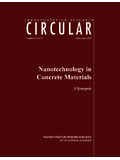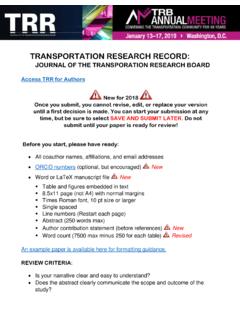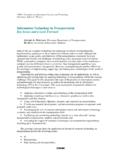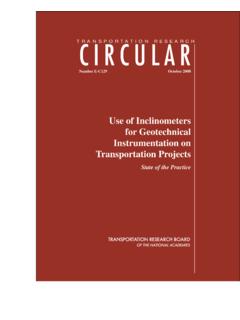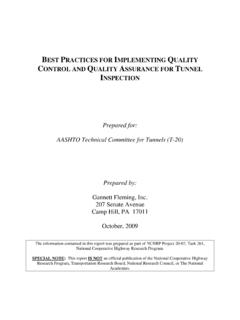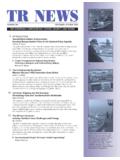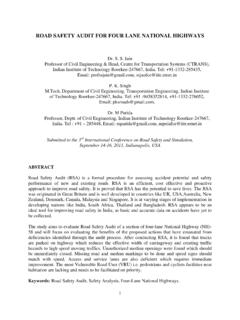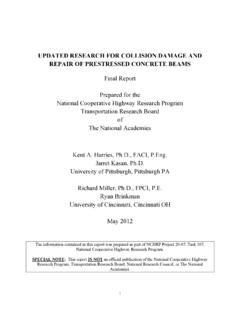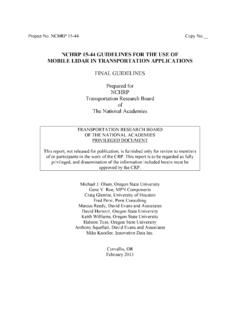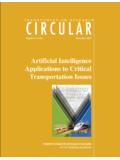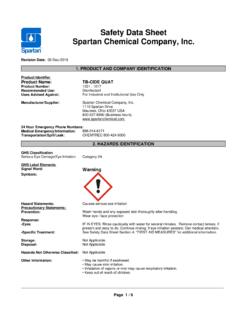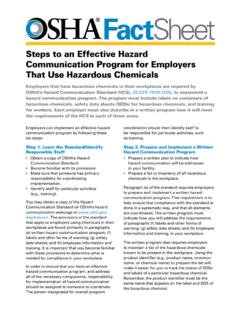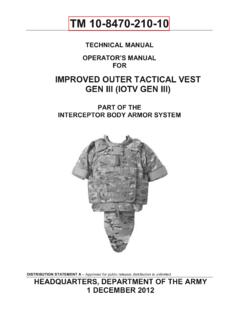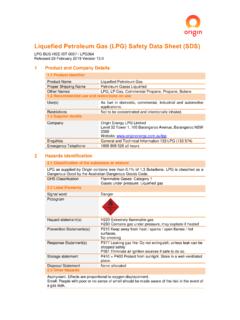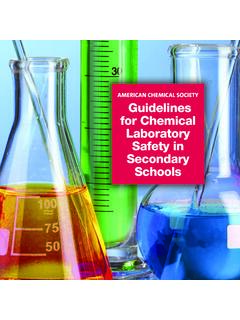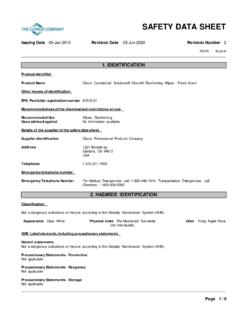Transcription of CULVERT AND STORM DRAIN SYSTEM INSPECTION MANUAL
1 Project No. 14-26 Copy No. ____. CULVERT AND STORM DRAIN SYSTEM . INSPECTION MANUAL . FINAL REPORT. Prepared for NCHRP 14-26 CULVERT and STORM DRAIN SYSTEM INSPECTION MANUAL Transportation Research Board of The National Academies TRANSPORTATION RESEARCH BOARD. OF THE NATIONAL ACADEMIES. PRIVILEDGED DOCUMENT. This document, not released for publication, is furnished only for review to members of or participating in the work of CRP. This document is to be regarded as fully privileged, and dissemination of the information included herein must be approved by CRP. Jesse L. Beaver Matthew C. Richie Simpson, Gumpertz & Heger, Inc. Waltham, MA. May 2016. ACKNOWLEDGMENT OF SPONSORSHIP. This work was sponsored by one or more of the following as noted.
2 American Association of State Highway and Transportation Officials, in cooperation with the Federal Highway Administration, and was conducted in the National Cooperative Highway Research Program, Federal Transit Administration and was conducted in the Transit Cooperative Research Program, Federal Aviation Administration and was conducted in the Airport Cooperative Research Program, Research and Innovative Technology Administration and was conducted in the National Cooperative Freight Research Program, Pipeline and Hazardous Materials Safety Administration and was conducted in the Hazardous Materials Cooperative Research Program, Federal Railroad Administration and was conducted in the National Cooperative Rail Research Program, which is administered by the Transportation Research Board of the National Academies.
3 DISCLAIMER. The opinions and conclusions expressed or implied herein are those of the Contractor. They are not necessarily those of the Transportation Research Board, the National Academies, or the program sponsors. ii TABLE OF CONTENTS. LIST OF AUTHOR ACKNOWLEDGEMENTS .. vi ABSTRACT .. vii SUMMARY ..1. CHAPTER 1 - Problem Statement ..4. Research Scope of MANUAL ..5. Summary of the State of Practice ..5. Intended Users and Uses ..6. Relationship with Other NCHRP CHAPTER 2 RESEARCH APPROACH ..7. Phase 1 Literature Phase 2 Develop a Catalog of Distressed Database of Copyright Release ..9. Phase 3 Evaluate INSPECTION Describe Best Practices for Identify INSPECTION Approaches and Create Develop INSPECTION Forms and Conduct Preliminary Field Inspections.
4 11. Phase 4 Develop Condition Assessment Criteria ..12. Numerical Ratings Descriptions ..13. Phase 5 Prepare the CULVERT INSPECTION MANUAL and Final Deliverables ..14. CHAPTER 3 INSPECTION MANUAL ..14. Organization of MANUAL ..15. Design and Performance INSPECTION Procedure ..16. Frequency of Types of Inspections ..18. INSPECTION Team and Rating SYSTEM ..21. Condition Assessment CHAPTER 4 Conclusions and Suggested Conclusions ..25. Suggested Future Research ..25. APPENDIX A - CULVERT AND STORM DRAIN SYSTEM INSPECTION A-1. iii LIST OF TABLES. Table 1 INSPECTION Frequency (Routine Inspections) ..17. Table 2 Rating Scale and Associated Table 3 Rating SYSTEM for Concrete iv AUTHOR ACKNOWLEDGMENTS. The research and work product presented in this report was conducted under NCHRP 14-26 by Simpson Gumpertz & Heger Inc.
5 The Principal Investigator for this work was Mr. Jesse L. Beaver. The Project Manager was Mr. Matthew C. Richie. The authors wish to thank and acknowledge the contributions, valuable feedback, and insight during this project from NCHRP Project Manager Dr. Waseem Dekelbab, members of the NCHRP Project Panel, the numerous parties who contributed valuable photographs for use in the MANUAL and condition assessment catalog, and the Simpson Gumpertz & Heger Inc. support staff who contributed to this effort. v ABSTRACT. The research presented in this report is conducted under NCHRP Project 14-26. The objective was to develop an INSPECTION MANUAL , primarily through an update of the 1986 FHWA MANUAL , for assessing the condition of in-service CULVERT and STORM DRAIN systems to ensure SYSTEM safety, functional performance, and the economical use of owner resources.
6 The final deliverable for NCHRP 14-26 is the CULVERT and STORM DRAIN SYSTEM INSPECTION MANUAL . The new MANUAL represents a complete overhaul of the condition rating SYSTEM and a change to component-level rating. The new MANUAL provides condition assessment criteria for plastic and timber pipe, and a distressed condition catalog as a photographic reference for assessing CULVERT and STORM DRAIN SYSTEM component condition. vi NCHRP 14-26. SUMMARY. In 1986, the Federal Highway Administration (FHWA) published the CULVERT INSPECTION MANUAL as a supplement to the bridge inspector's training MANUAL . Until now, that work remained the most comprehensive publication on the topic. Since that time, there have been significant advances in CULVERT and STORM DRAIN systems, INSPECTION methods, and asset management.
7 In particular, plastic pipe, not addressed at all in the 1986 MANUAL , is now widely used for highway culverts and STORM drains. Three decades of change created a need to develop an updated MANUAL to provide guidance on best practices to inspect and evaluate culverts. The objective of NCHRP 14-26 was to develop an INSPECTION MANUAL , primarily through updating the 1986 FHWA MANUAL , for assessing the condition of in-service CULVERT and STORM DRAIN systems to ensure SYSTEM public safety, functional performance, and the economical use of owner resources. The final deliverable for NCHRP 14-26 is the CULVERT and STORM DRAIN SYSTEM INSPECTION MANUAL . This MANUAL represents a complete overhaul of the 1986 MANUAL , and in particular to the condition rating SYSTEM .
8 To achieve usable results, the INSPECTION findings must be accurate and consistent. Clear definitions are needed to show how the ratings are applied. Definitions need to be quantifiable so that they reduce opportunity for interpretation that can lead to variation between inspectors. After a detailed review of the existing rating SYSTEM , the research team identified many opportunities for revision to the condition rating descriptions: The numerical rating SYSTEM was changed to a five-point rating SYSTEM from a ten-point rating SYSTEM . Repeatability is key to successful implementation of a CULVERT and STORM DRAIN INSPECTION and assessment SYSTEM , and the ten-point scale offered unnecessary ambiguity and interpretation between ratings.
9 The revised five-point scale also directly correlates observed conditions with recommended action. The format of the ratings descriptions is reorganized to a component-level evaluation, consistent with the AASHTO Bridge Element INSPECTION MANUAL . This format provides a better user experience and less confusion for the basis of a particular rating. Components are rated individually with potential distress and their associated severity rated on a scale of 1 (good condition) through 5 (failed condition). New materials and components have been added to the MANUAL . Additions to the rating SYSTEM include timber and plastic CULVERT / STORM DRAIN barrels, joints (based on AASHTO performance criteria), manholes, catch basins, and buried junctions.
10 Most importantly, the new rating descriptions were developed with a focused effort on incorporating quantitative measures of distress. Research indicated that previous distress descriptors left too much room for interpretation. Adjectives such as mild or significant are now accompanied by quantitative definitions to remove ambiguity and interpretation between inspectors. The quantitative rating descriptions are based on consensus standards from a broad range of sources compiled during our literature review, including industry and manufacturer's literature, design standards, and the collective experience of the research team. This research also developed updated INSPECTION techniques, provided recommendations for INSPECTION frequency, and added a catalog of distressed conditions for CULVERT and STORM DRAIN SYSTEM distress identification.
